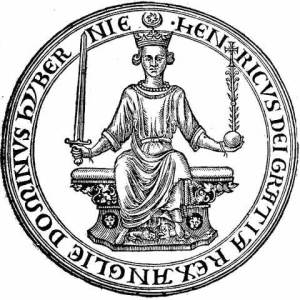It was Christmas 1223, the rebel alliance (the Schismatics) were on the run. They planned to meet in ‘great array’ at the castle of Northampton which was held by one of the rebels, Sheriff of Northampton, . However, they were beaten to it, and on 23 December, the young King Henry III arrived at Northampton Castle with Stephen Langton, Archbishop of Canterbury and many bishops, earls, barons and Knights intending to spend Christmas there. It was not the first time, the King had celebrated Christmas at Northampton, as de Breauté, had entertained him in the castle after the victory at the Battle of Lincoln Fair during Christmas 1217. The Dunstable annalist noted that neither in the days of his father (King John), nor afterwards, is such a feast known to have been celebrated in England. The next day Langton excommunicated all the rebels, and they were summonsed to appear before the King at Northampton on 30 December. When they arrived the Schismatics were shown letters from the Pope ordering the restoration of their castles to the King. They surrendered their castles and de Breauté and the Earl of Chester lost their sheriffdoms. It was not until mid Jan that Ralph de Trublevill was appointed as de Breautés replacement. The following June, de Breauté was convicted of 16 charges of seizing other peoples land. In reply he captured one of the judges Henry of Braybrook in Northants and threw him in the dungeon of his last surviving castle at Bedford. The King who had been at Northampton ordered his army to march on Bedford. It was to be one of the longest sieges during this period lasting eight weeks, with over 200 killed by the missiles of the defenders. After a fourth assault broke the walls de Breautés brother William and 80 knights were captured, refused pardon and hanged. De Breauté himself was exiled and died in 1226, allegedly from a poisoned fish.
Category: Battle of Northampton 1174
In 1173 Henry II’s sons Henry and Richard (future Richard the Lionheart) rebelled against their father, supported by Louis, King of France.
Major baronial revolts broke out in England, Brittany, Maine, Poitou and Angoulême. In Normandy some of the border barons rose up and, although the majority of the duchy remained openly loyal, there appears to have been a wider undercurrent of discontent.
In May 1173 Louis and the Young King probed the defences of the Vexin, the main route to the Norman capital, Rouen; armies invaded from Flanders and Blois, attempting a pincer movement, while rebels from Brittany invaded from the west.
In July 1173, Henry secretly traveled back to England to order an offensive on the rebels, meeting his Barons at Northampton, giving them instructions and then returning. Chief Justicar, Richard de Lucy captures the town but not the castle of Leicester.
In September, Earl Robert of Leicester lands with an army of Flemish mercenaries and meets with Earl Hugh Bigod at Framlingham, intending to relieve Leicester. They capture the royal castle at Haughley.
On 17 Oct 1173, Royal forces under the command of Richard de Lucy, the Chief Justiciar surprise the rebels at Fornham as well as Humphrey de Bohun Lord High Constable, Reginald de Dunstanville, the Earl of Cornwall, William of Gloucester, the Earl of Gloucester, and William d’Aubigny, the Earl of Arundel, the Earl of Norfolk’s son, Roger Bigod intercept the rebels fording the River Lark about 4 miles (6.4 km) north of Bury St Edmunds.
The rebel forces numbering around 3000 mercenaries were caught fording the River Lark about 4 miles (6.4 km) north of Bury St Edmunds. With his forces split, Leicester’s cavalry was captured and his mercenaries were driven into nearby swamps where the local peasants killed most of them. Leicester was captured, as was his wife, Petronilla de Grandmesnil, who had put on armour herself. She is said to have fled from the battle, only to be found in a ditch wanting to drown herself, Leicester remained in captivity until January 1177 when some of his lands were returned to him.
David, Earl of Huntingdon, brother of Scottish King William goes to the relief of Leicester. Simon de Senlis III, Earl of Northampton, is told by King Henry he can have Huntingdon – if he can capture it so promtly lays siege to it. To draw the royal army away from Huntingdon, on May 1174, an army led by Ansketill Malory, Constable of Leicester attacks Northampton. Although details are scant, it appears a battle took place under the walls of the town (possibly outside the north gate). The Burghers of the town are beaten with 200 killed and 200 taken prisoner. The victors then assault Nottingham.
Then on 8 July 1174, Henry arrives in England, first travelling to Becket’s tomb in Canterbury, where he announced that the rebellion was a divine punishment on him, and took appropriate penance. On 13 July, King William was defeated and captured by local forces in a short battle at Alnwick, crushing the rebel cause in the north. He is taken to Northampton, his feet tied under a horse, where he is brought before King Henry. Eventually King William is transferred to Falaise where he is forced to sign a treaty renouncing Scottish claims on Northumberland.
Henry then marches to Huntingdon which surrenders. The remaining English rebel strongholds quickly collapse and Henry accepts the rebels surrender at Northampton.
